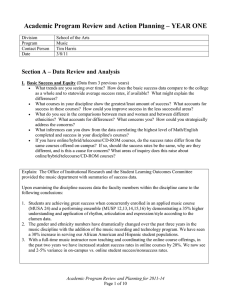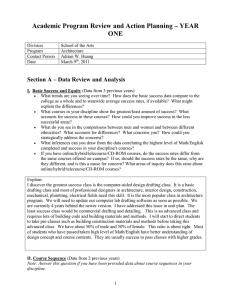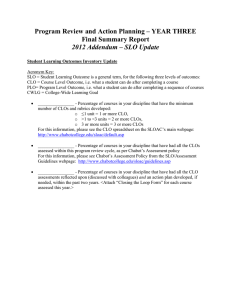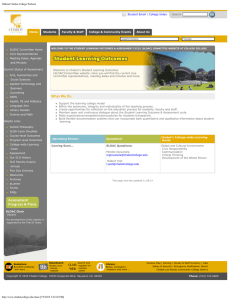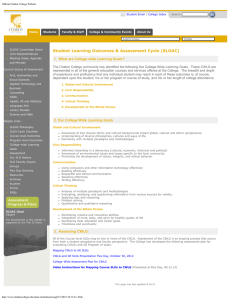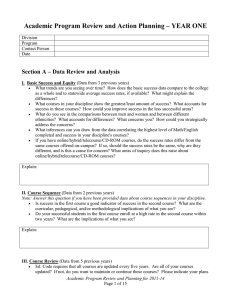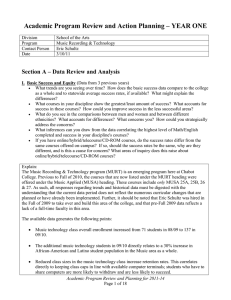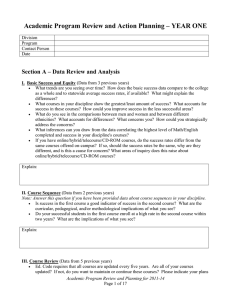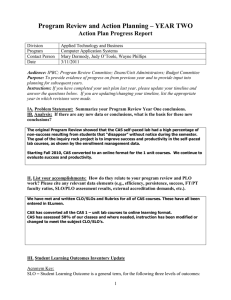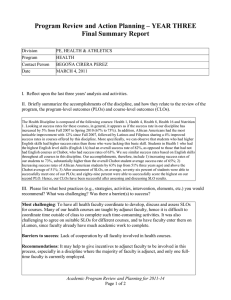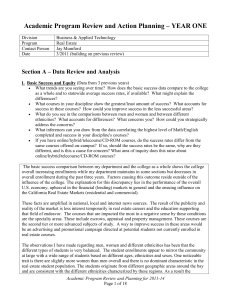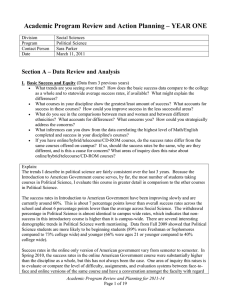Academic Program Review and Action Planning – YEAR ONE
advertisement
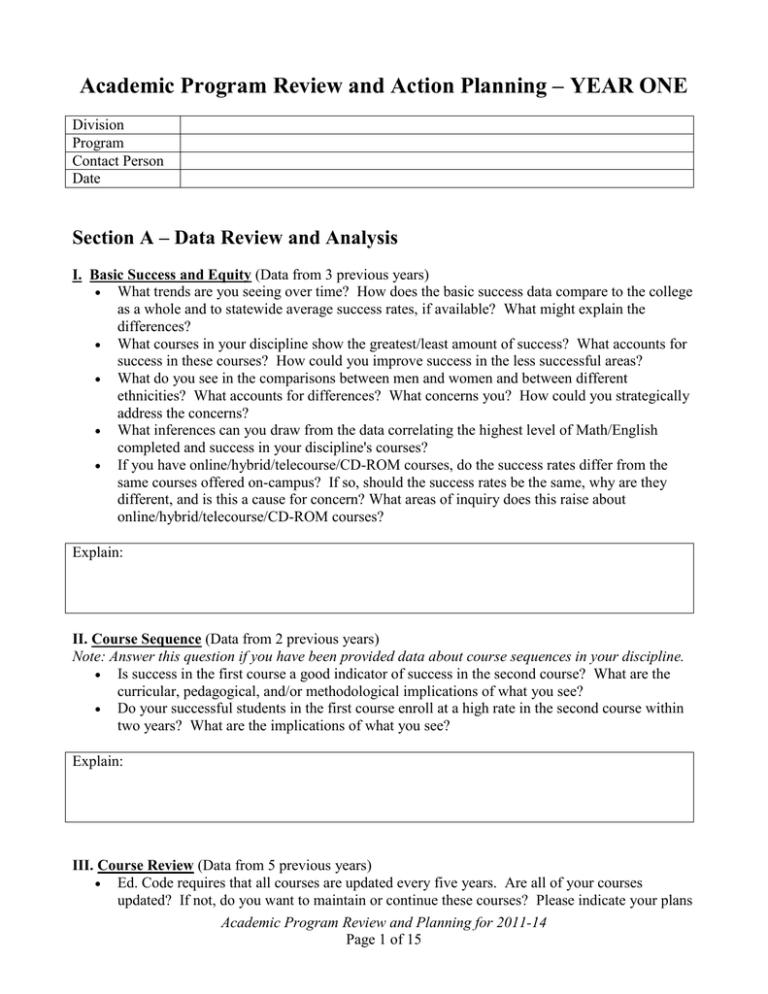
Academic Program Review and Action Planning – YEAR ONE Division Program Contact Person Date Section A – Data Review and Analysis I. Basic Success and Equity (Data from 3 previous years) What trends are you seeing over time? How does the basic success data compare to the college as a whole and to statewide average success rates, if available? What might explain the differences? What courses in your discipline show the greatest/least amount of success? What accounts for success in these courses? How could you improve success in the less successful areas? What do you see in the comparisons between men and women and between different ethnicities? What accounts for differences? What concerns you? How could you strategically address the concerns? What inferences can you draw from the data correlating the highest level of Math/English completed and success in your discipline's courses? If you have online/hybrid/telecourse/CD-ROM courses, do the success rates differ from the same courses offered on-campus? If so, should the success rates be the same, why are they different, and is this a cause for concern? What areas of inquiry does this raise about online/hybrid/telecourse/CD-ROM courses? Explain: II. Course Sequence (Data from 2 previous years) Note: Answer this question if you have been provided data about course sequences in your discipline. Is success in the first course a good indicator of success in the second course? What are the curricular, pedagogical, and/or methodological implications of what you see? Do your successful students in the first course enroll at a high rate in the second course within two years? What are the implications of what you see? Explain: III. Course Review (Data from 5 previous years) Ed. Code requires that all courses are updated every five years. Are all of your courses updated? If not, do you want to maintain or continue these courses? Please indicate your plans Academic Program Review and Planning for 2011-14 Page 1 of 15 in terms of curriculum. Have all of your courses been offered recently? If not, why? Are students counting on courses to complete a program or major when these courses are not being offered? Explain: IV. Budget Summary (Data from 3 previous years) What budget trends do you see in your discipline? What are the implications of these trends? Where is your budget adequate and where is it lacking? What are the consequences on your program, your students, and/or your instruction? What projected long-term (5-10 years) budget needs do you see? You will detail your short-term needs in the action plan that follows. You do not need to cite them here. Explain: V. Enrollment Data (Data from 2 previous years) Please provide a brief description of: overall enrollment trends; enrollment trends by course; and enrollment trends by time of day and Saturday. Describe what your discipline has done in terms of curriculum or scheduling in the last two years that has effected enrollments. Describe plans or strategies that you have for the near future in terms of curriculum or scheduling that could impact your enrollments. Lastly, look closely at whether the schedule you currently offer provides access to the broader community that your discipline serves at Chabot College—day time, night time, Saturday, distance education, special or targeted communities that would or do enroll in your courses. Explain: Academic Program Review and Planning for 2011-14 Page 2 of 15 VI. Student Learning Outcomes Inventory Acronym Key: SLO = Student Learning Outcome is a general term, for the following three levels of outcomes: CLO = Course-level Outcome, i.e. what a student can do after completing a course PLO= Program-level Outcome, i.e. what a student can do after completing a sequence of courses CWLG = College-wide Learning Goal Percentage of courses in your discipline that have CLOs and rubrics developed:_________ For this information, please see the list of which courses do and do not have CLOs on the SLOAC’s main webpage: http://www.chabotcollege.edu/sloac/default.asp Percentage of courses in your discipline that have the minimum number of CLOs developed: (1 unit = 1 or more CLO, 2 units = 2 or more CLOs, 3 or more units = 3 or more CLOs)_______ For this information, please see the CLO spreadsheet on the SLOAC’s main webpage: http://www.chabotcollege.edu/sloac/default.asp Date the CLO Assessment schedule was submitted:________ For this information, please see the Course-level Outcomes assessment schedules list from the Assessment Progress and Plans webpage: http://www.chabotcollege.edu/sloac/progress.asp Percentage of courses in your discipline that have had all the CLOs assessed within the past three years, as per Chabot’s Assessment policy: _______ For this information, please see Chabot’s Assessment Policy from the SLO/Assessment Guidelines webpage: http://www.chabotcollege.edu/sloac/guidelines.asp Percentage of courses in your discipline that have had all the CLO assessments reflected upon, or discussed with colleagues, within the past three years_______ What questions or investigations arose as a result of these reflections or discussions? Explain: What actions has your discipline determined that might be taken as a result of these reflections, discussions, and insights? Actions planned: What course-level and programmatic strengths have the assessment reflections revealed? Strengths revealed: Academic Program Review and Planning for 2011-14 Page 3 of 15 Percentage of programs within your discipline that have established at least two PLOs, and mapped appropriate CLOs to them:________ For this information, please see the Program-level Outcomes progress page from the Assessment Progress and Plans webpage: http://www.chabotcollege.edu/sloac/progress.asp Which of the CWLGs do your discipline’s CLOs address? ______________________________ ______________________________________________________________________________ In which if any of the College-wide Learning Goals Faculty Inquiry Groups have discipline member(s) participated? _________________________________________________________ ______________________________________________________________________________ Insights gained: VII. Academic Learning Support What kinds of academic learning support does your discipline use or require to help students succeed (e.g., tutoring, learning assistants, student assistants, peer advisors, lab support, supplemental instruction, peer-led team learning, peer advisors)? How many hours per semester do you use and/or how many hours per semester do you need? Explain: VIII. External Data Cite any relevant external data that affects your program (e.g., labor market data, community demand, employment growth, external accreditation demands, etc.). Academic Program Review and Planning for 2011-14 Page 4 of 15 Section B – Data Summary From what you have learned in your basic data review, what does the information tell you about your program? Overall, what improvements would you like to make to your program? How do you plan to address these concerns? Are there any immediate issues that require immediate attention (e.g., outdated course outlines)? Where appropriate, please cite relevant data in your discussion (e.g., efficiency, persistence, success, FT/PT faculty ratios, SLO/PLO assessment results, external accreditation demands, etc.). Data Summary and Plan of Action Description/Rationale: Section C – Action Planning Please propose a two-year plan of action and timeline to address any immediate and/or long-term concern(s). This includes activities to assess the CLO(s) to discover a plan of action. It may also include specific activities that address improving CLO(s) and their assessment, that is to say evaluating the CLO(s) and the assessment activities. Examples of activities include: Research and inquiry project – why is this happening? Innovation and Pilot Projects – this is something I want to try Intervention activities such as support services – this is what I want to do about it Program and curriculum modification – this is what I want to do about it 5 I. Action Plan Timeline: Detail the timeline for accomplishing your goals PLOs and/or Program Goal(s) Timeline Activity Support Needed to Accomplish These Activities* Outcome(s) Expected Person(s) Responsible Accomplished? Yes/No/In Progress YEAR ONE LEAVE BLANK Definitions of terms: Program Goal = A general statement of what the program hopes to accomplish, for the long-term. It may be in qualitative (narrative) rather than quantitative (numeric) terms. It may include the integration of several program outcomes, or relate to class scores, credits, units, course completion, retention term to term, progression to next course/level, program completion, degree and certificate completion, transfer, success/scores on licensure exams, job placement, attitudes, fundraising, media promotion, etc. PLO = Program-level Outcome, i.e., what students can do, what knowledge they have, after completing a sequence of courses. It is a subset of the Program Goals, related to student learning. *Types of Support Needed to Accomplish Activities: Training or workshops Publications, library, resources Guidance to support research and/or inquiry projects Technology 6 II. Strategic Plan Goals and Summaries: Which Strategic Plan goals and strategies does your action plan support? Awareness and Access Increase familiarity with Chabot Reach out to underrepresented populations Promote early awareness and college readiness to youth and families Multiple ways to deliver instruction and services for all Student Success Strengthen basic skills development Identify and provide a variety of career paths Increase success for all students in our diverse community Assess student learning outcomes to improve and expand instruction and services Community Partnership Increase experiential learning opportunities Initiate/expand partnerships among the college, businesses and community organizations Promote faculty and staff involvement in college and community activities Engage the community in campus programs and events Vision Leadership and Innovation Improve institutional effectiveness Streamline academic and student support services Professional development to support teaching, learning and operational needs Support effective communication both in the college and the community Provide safe, secure and up-to-date facilities and technology 7 Program Review and Action Planning – YEAR TWO Action Plan Progress Report Division Program Contact Person Date Audience: IPBC; Program Review Committee; Deans/Unit Administrators; Budget Committee Purpose: To provide evidence of progress on from previous year and to provide input into planning for subsequent years. Instructions: If you have completed your unit plan last year, please update your timeline and answer the questions below. If you are updating/changing your timeline, list the appropriate year in which revisions were made. IA. Problem Statement: Summarize your Program Review Year One conclusions. IB. Analysis: If there are any new data or conclusions, what is the basis for these new conclusions? II. List your accomplishments: How do they relate to your program review and PLO work? Please cite any relevant data elements (e.g., efficiency, persistence, success, FT/PT faculty ratios, SLO/PLO assessment results, external accreditation demands, etc.). III. Student Learning Outcomes Inventory Update Acronym Key: SLO = Student Learning Outcome is a general term, for the following three levels of outcomes: CLO = Course-level Outcome, i.e. what a student can do after completing a course PLO= Program-level Outcome, i.e. what a student can do after completing a sequence of courses CWLG = College-wide Learning Goal 8 Percentage of courses in your discipline that have CLOs and rubrics developed:_________ For this information, please see the list of which courses do and do not have CLOs on the SLOAC’s main webpage: http://www.chabotcollege.edu/sloac/default.asp Percentage of courses in your discipline that have the minimum number of CLOs developed: (1 unit = 1 or more CLO, 2 units = 2 or more CLOs, 3 or more units = 3 or more CLOs)_______ For this information, please see the CLO spreadsheet on the SLOAC’s main webpage: http://www.chabotcollege.edu/sloac/default.asp Date the CLO Assessment schedule was submitted:________ For this information, please see the Course-level Outcomes assessment schedules list from the Assessment Progress and Plans webpage: http://www.chabotcollege.edu/sloac/progress.asp Percentage of courses in your discipline that have had all the CLOs assessed within the past three years, as per Chabot’s Assessment policy: _______ For this information, please see Chabot’s Assessment Policy from the SLO/Assessment Guidelines webpage: http://www.chabotcollege.edu/sloac/guidelines.asp Percentage of courses in your discipline that have had all the CLO assessments reflected upon, or discussed with colleagues, within the past three years_______ What questions or investigations arose as a result of these reflections or discussions? Explain: What actions has your discipline determined that might be taken as a result of these reflections, discussions, and insights? Actions planned: What course-level and programmatic strengths have the assessment reflections revealed? Strengths revealed: Percentage of programs within your discipline that have established at least two PLOs, and mapped appropriate CLOs to them:________ For this information, please see the Program-level Outcomes progress page from the Assessment Progress and Plans webpage: http://www.chabotcollege.edu/sloac/progress.asp Which of the CWLGs do your discipline’s CLOs address? _________________________________________________________________________ _________________________________________________________________________ 9 In which if any of the College-wide Learning Goals Faculty Inquiry Groups have discipline member(s) participated? _________________________________________________________________________ _________________________________________________________________________ Insights gained: VII. Academic Learning Support What kinds of academic learning support does your discipline use or require to help students succeed (e.g., tutoring, learning assistants, student assistants, peer advisors, lab support, supplemental instruction, peer-led team learning, peer advisors)? How many hours per semester do you use and/or how many hours per semester do you need? Explain: IV. External Data Cite any relevant external data that affects your program (e.g., labor market data, community demand, employment growth, external accreditation demands, etc.). 10 V. Action Plan Timeline Update: Cut and paste your previous timeline from Year One and update the “Accomplished?” column. List any new PLOs or program goals and activities you may have in the second chart. PLOs and/or Program Goal(s) from Year One Timeline Activity Support Needed to Accomplish these Activities* Outcome(s) Expected Person(s) Responsible Accomplished? Yes/No/In Progress New PLOs and/or Program Goal(s) Timeline Activity Support Needed to Accomplish these Activities* Outcome(s) Expected Person(s) Responsible Accomplished? Yes/No/In Progress YEAR TWO LEAVE BLANK 11 Definitions of terms: 1. Program Goal = A general statement of what the program hopes to accomplish, for the long-term. It may be in qualitative (narrative) rather than quantitative (numeric) terms. It may include the integration of several program outcomes, or relate to class scores, credits, units, course completion, retention term to term, progression to next course/level, program completion, degree and certificate completion, transfer, success/scores on licensure exams, job placement, attitudes, fundraising, media promotion, etc. PLO = Program-level Outcome, i.e., what students can do, what knowledge they have, after completing a sequence of courses. It is a subset of the Program Goals, related to student learning. *Types of Support Needed to Accomplish Activities: Training or workshops Publications, library, resources Guidance to support research and/or inquiry projects Technology 12 Program Review and Action Planning – YEAR THREE Final Summary Report Division Program Contact Person Date School of the Arts Digital Media Mark Schaeffer March 11, 2011 I. Reflect upon the last three years' analysis and activities. II. Briefly summarize the accomplishments of the discipline, and how they relate to the review of the program, the program-level outcomes (PLOs) and course-level outcomes (CLOs). Accomplishments: Nearly all of our classes have been full or impacted; retention has improved. I take no credit for the high enrollments (which I assume are due to reduced course offerings elsewhere), but I would like to think that the improved retention is due to my increased experience in teaching these courses. I almost never teach a course the same way twice; the more times I teach a course, the more opportunities I have to refine what works and replace what doesn’t. Many former students have reported that the skills they acquired in Digital Media courses have helped them in their careers —and not necessarily art- or design-related careers. (Being able to edit a photo or build a website is useful even for students who work in stores or offices; employees who can do those things — even if it’s not part of their job description — are often promoted ahead of their colleagues.) Students who go on to four-year colleges often tell me that they learned more in their Digital Media courses at Chabot than in those more prestigious institutions; some come back to take more of our courses even after they’ve received their bachelor’s degree. These accomplishments are entirely unrelated to PLOs and CLOs, which I find to be irrelevant to what goes on in the classroom. Students take Digital Media courses for an unusually wide variety of reasons: A single class might include people with a mild curiosity about how to use a piece of software that came with their computer, students who have no intention of using the software but are taking the course because it’s required for their degree or certificate, artists who are looking for a new way to express themselves, mid-career learners in diverse professions who hope that expanding their skill set will help them get ahead, experienced users of the software who are selftaught and want to fill in the gaps in their knowledge, young people who want to build a career in digital media, and retired people who are just looking for something interesting to do with their time. What purpose would it serve for me to tell these people what I think they ought to be learning? Each person is there to learn specifically what he or she wants to learn, and my job is to facilitate that process. My good-faith attempt to implement a measurement of outcomes was to ask each student, on the first day of class, to list one or two things that he or she wanted to get from the course; then, on the last day of class, to ask that student to rate, on a scale of 1 to 5, how close he or she had come to reaching each goal. I was told, however, that my process didn’t fit the institutional definition of developing and assessing SLOs. So I am now handling SLOs in the prescribed fashion: I’ve written a rubric-style SLO for each course, and I assess each SLO and complete the “closing the loop” form according to the schedule I submitted. This process does not yield any useful insights or plans for action; however, I trust it will satisfy the SLO requirement to the extent that the college can continue to be accredited. III. Please list what best practices (e.g., strategies, activities, intervention, elements, etc.) you would recommend? What was challenging? Was there a barrier(s) to success? Best practices: 13 Looking at students’ statements of their goals when they enter my courses, I see that most of them do not intend to pursue careers in digital media; and because career opportunities are limited, the students who are seeking those kinds of jobs most likely won’t be able to find them. I want all of my students to benefit from taking Digital Media courses, not just the few who will be doing this work professionally. Therefore, it’s important to place the emphasis on critical thinking, intellectual curiosity, working responsibly, and problem-solving — skills and attitudes that will aid students no matter what they do in life — rather than on covering every detail about each new software version that comes onto the market. Challenges/Barriers to Success: The biggest barrier to success is our students’ complex lives: Jobs, family responsibilities, transportation issues, court dates (and for some, poverty and homelessness) limit the amount of time they can devote to their studies. Some of the skills we teach — particularly Flash animation and programming — are quite time-consuming, and many of our students, despite their best intentions, don’t have the necessary time to devote to their projects. Even those who do have the time may not have the resources. Many can’t afford to buy the software, and even those who can afford it may not have access to a computer to run it on. (Many share a single computer with other family members.) In theory, this shouldn’t be a problem; every student should have access to fully equipped computers in Chabot’s labs, so they don’t need to own the hardware and software. In practice, however, we don’t have the funding to keep our labs open for a sufficient number of hours (in particular on evenings and weekends, which is when many students have free time). As a result, students who are financially better off, and who can therefore do their work at home, are more likely to succeed in our courses. This is not as it should be. One more barrier to success, obviously, is the college’s severely reduced budget. At the end of this semester, Cedric Pounds — the only adjunct instructor in Digital Media, who taught Final Cut Pro — will be gone due to reduced FTEF. As a result, I’m going to have to teach his courses, and I can honestly say that I’m not as well equipped to teach them as Cedric was. (I have years of experience in digital video editing, but have not done it for quite a while, and so I don’t have the up-to-the minute field experience that Cedric has.) When one instructor teaches the entire range of courses in a discipline, that instructor clearly can’t have an equally high degree of expertise in all of them; it’s always useful to have adjuncts — who are generally still working in the field — come in to teach the skills they specialize in. The elimination of adjuncts from this and other disciplines results in a reduced quality of education for the students. IV. Next Steps: Recommendations for program and institutional improvement. Program Improvement: I realize that these recommendations can’t possibly be fulfilled, since we’re in a period of cutting FTEF rather than adding it. However, since you asked: We offer courses in every fundamental area of digital media except one: page layout and design. Our computers are equipped with the Adobe Design Premium suite, whose core applications are Photoshop, Illustrator, Flash, Dreamweaver, and InDesign; of those, only InDesign (the page-layout application) goes unused and untaught. All of our current FTEF goes toward courses in those other four applications along with Final Cut Pro, the industrystandard video editing application. For years, I’ve been requesting additional FTEF so we can offer an InDesign course, given that we already have the software. All I can do is to continue requesting it. I would also like to offer higher-level courses in the subjects we already do offer — for example, advanced Photoshop, advanced video editing, or advanced web development. (As with InDesign, we already have the software.) Obviously, we can’t eliminate lower-level courses and replace them with higher-level courses, since the former are necessary prerequisites for the latter. The advanced courses would have to be in addition to what we have now, and therefore would require more FTEF. Finally, there are other areas in which students have been asking for courses, chiefly 3D graphics and animation and game design. Obviously this isn’t going to happen anytime soon, but that’s our long-range goal. 14 Institutional Improvement: Chabot must find a way to give students more access to the computers and software that will allow them to get their work done. (See the second paragraph of Challenges/Barriers, above.) Ideally, this would come in the form of funding for part-time lab assistants who could keep our labs open for longer hours. Another possibility — which I have raised for many years now — would be to have a campus-wide software server, so that students could access programs such as Photoshop, Illustrator, and so on from computers outside the Digital Media labs. This would allow students to get their work done in the library (in conjunction with textbooks on reserve in the library) even when the Digital Media labs are closed. Obviously, this is not going to happen anytime soon due to budget constraints, but in that case we need to be honest with our students: We need to tell them that if they can’t afford their own hardware and software, they’re less likely to succeed in Digital Media courses. 15
